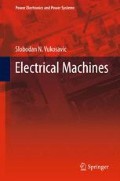Abstract
In this chapter, examples of single-fed and double electromechanical converters are analyzed and explained. In both cases, the torque changes are analyzed in cases where the windings have DC currents and AC currents of adjustable frequency. Revolving magnetic field created by AC currents in the windings is introduced and explained. Using the previous considerations, some basic operating principles are given for DC current machines, induction machines, and synchronous machines.
Access this chapter
Tax calculation will be finalised at checkout
Purchases are for personal use only
Notes
- 1.
In cases where machine has p pairs of poles, the condition for torque development is ω 1 ± ω 2 ± pΩ m = 0. Notation Ω m is angular speed of rotor motion, hence mechanical speed. Angular frequency ω m = pΩ m is electrical representation of the rotor speed. It defines the period T ωm = 2π/ω m which marks passing of north magnetic poles of the rotor against north magnetic poles of the stator. With p > 1, this happens more than once per each mechanical revolution. In a machine with p > 1 pole pairs, angular distance between the two neighboring north poles is Ω m T ωm = 2π/p. A four pole machine (p = 2) has two north and two south poles. Two north poles are at angular distance of Ω m T ωm = 2π/2 = π. Therefore, any north magnetic pole of the rotor passes against stator north pole twice per turn. In a two-pole machine (p = 1), starting from the north magnetic pole, one should pass angular distance of Ω m T ωm = 2π/1 = 2π in order to arrive at the next north pole, the very same pole from where one started. Namely, a two-pole machine has only one north magnetic pole and one south magnetic pole.
- 2.
In a two-pole DC machine, the number of pole pairs is p = 1. Therefore, ω 2 = pΩ m = Ω m . With p > 1, the condition reads ω 2 = ω m = pΩ m .
- 3.
In a two-pole induction motor, p = 1.
- 4.
Example in Fig. 7.8b considers a two-pole machine having p = 1 pair of magnetic poles. Due to ω = pΩ and p = 1, mechanical speed (angular frequency) Ω corresponds to electrical speed (angular frequency) ω.
- 5.
There exist synchronous machines that have permanent magnets in place of DC excited rotor windings.
Author information
Authors and Affiliations
Rights and permissions
Copyright information
© 2013 Springer Science+Business Media New York
About this chapter
Cite this chapter
Vukosavic, S.N. (2013). Single-Fed and Double-Fed Converters. In: Electrical Machines. Power Electronics and Power Systems. Springer, New York, NY. https://doi.org/10.1007/978-1-4614-0400-2_7
Download citation
DOI: https://doi.org/10.1007/978-1-4614-0400-2_7
Published:
Publisher Name: Springer, New York, NY
Print ISBN: 978-1-4614-0399-9
Online ISBN: 978-1-4614-0400-2
eBook Packages: EnergyEnergy (R0)

